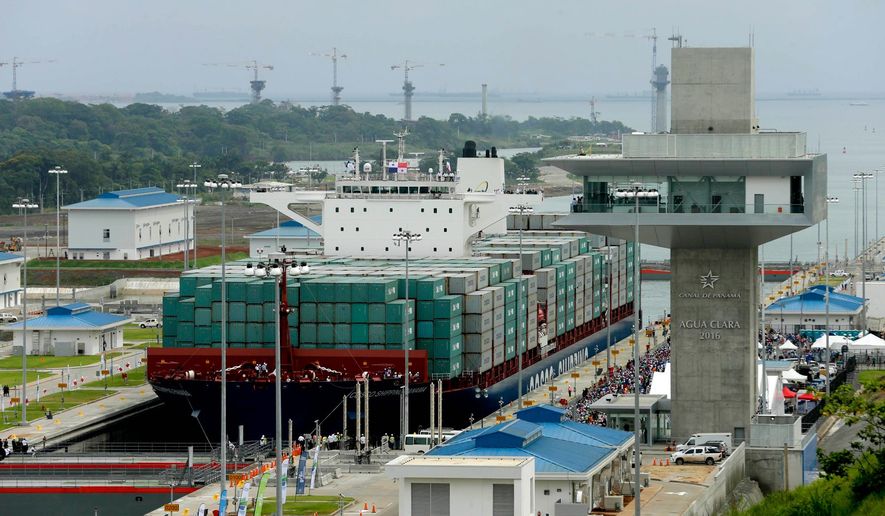OPINION:
On Dec. 14, the Chinese ship YM Unity became the 500th vessel to pass successfully throughthe expanded Panama Canal. The new set of locks and deeper navigation channels represent a technological feat that nearly triples container capacity, while using 7 percent less water than the original canal. Now, a total of 140 maritime routes and 1,700 ports around the globe are connected by the expanded canal.
Yet despite the obvious accomplishments, much of what has thus far been written about the expanded canal has ranged from mildly skeptical to downright negative. These criticisms have focused on cost overruns, missed deadlines, the impact of flagging global trade, and safety concerns.
Part of this negativity comes with the territory: an expectation that all large and complex construction projects will come in over budget and behind schedule. The canal expansion was significantly over budget and its opening delayed by 18 months. Still, colossal construction projects often involve cost overruns and delays, largely due to unforeseen conditions, common in all but the most routine construction. Take for example Boston’s “Big Dig,” New York’s Second Avenue subway, the Eurotunnel, and the airports in Berlin and Doha, just to name a recent few.
Much has also been made of impact of the slowdown of global trade on the canal’s expected traffic. But this is a short-term view, and even if world trade were to remain flat for a time, more of that trade will go through the Panama Canal, which can now handle 79 percent of total global traffic, compared to only 45 percent that could fit through the original passageway.
Finally, just as the canal was nearing completion, reports surfaced about leaky locks, concrete flaws and tugboat problems. But the predictions of a poorly constructed canal, unprepared for its inauguration, just didn’t materialize. On the contrary, the canal has worked perfectly since its June 26 opening, and not one single construction flaw has been evidenced.
Even with tugboats guiding ships — a significant departure from the locomotives in use at the original canal — there has been only one minor operational incident. A Chinese vessel incurred a slight abrasion as it approached one of the locks. The damage was minimal precisely because the buffers, which are in place to deal with such situations, performed as expected. Further, as tugboat captains gain experience, this type of incident should be greatly minimized if not eliminated entirely.
So why all the negativity surrounding what is proving to be a highly successful, world-class endeavor? At the heart of this naysaying have been ongoing labor disputes between the Panama Canal Authority’s (ACP) and the multiple unions representing canal workers.
The expanded canal is a technological marvel, more efficient and less labor-intensive than the original canal and able to move larger ships at a lower per-unit cost. A key element of this technology is the use of tugboats, rather than locomotives, to haul ships through the new locks, allowing greater flexibility and simplicity, saving energy, and improving operating efficiency. This decision, however, provoked an outcry from labor unions, which wanted to retain the old locomotives and the jobs they represented. Furthermore, the Unin de Capitanes y Oficiales de Cubierta (UCOC), representing tugboat personnel, repeatedly agitated for the use of more tugboats and more staff, arguing the point on safety and operational grounds.
Notably, some of the worst criticisms of the canal arose in the midst of acrimonious contract negotiations. From mid-2015 through June 2016, the unions repeatedly and publicly voiced negative and pessimistic concerns about the canal’s safety, operation and future. Yet once the UCOC signed a four-year agreement with the ACP on July 28, the criticisms came to an abrupt end. Today, the major labor unions representing canal workers, including the UPTNP which speaks for 80 percent of employees, have long-term agreements in place. Only maintenance workers and firefighters have yet to come into the fold.
Much of the criticism of the expanded canal was a union negotiating tactic, largely successful, to pressure the ACP to conclude labor agreements on favorable terms. Concerned about unfair and exaggerated critiques of the canal, the ACP quickly concluded agreements with the UCOC and other unions shortly after the most strident attacks on the canal were published in major U.S. media outlets.
With the labor disputes at an end, it’s time to take a more balanced view of the expanded Panama Canal. The canal is operating flawlessly. Ships are reserving passage at the expected rate. U.S. and other international port cities are seeing the canal’s positive effects on their economies. The vast majority of all container ships on the high seas can now pass through the Panamanian isthmus, a decided benefit to global trade. Panama, a beacon of economic and political stability in Central America, will collect $1.6 billion annually from passage fees, a significant sum in a country with a total budget of $25 billion, thus further strengthening the nation’s social programs and economy.
When all is said and done, the expanded canal can undoubtedly take its place as a fitting companion and worthy successor to the original Panama Canal.
• Hector V. Barreto is a former administrator of the U.S. Small Business Administration.




Please read our comment policy before commenting.